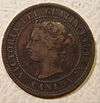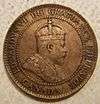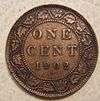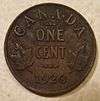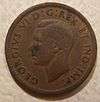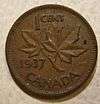Penny (Canadian coin)
| Canada | |
| Value | 0.01 CAD |
|---|---|
| Mass | 2.35 g |
| Diameter | 19.05 mm |
| Thickness | 1.45 mm |
| Edge | smooth |
| Composition |
94% steel, 1.5% Ni, 4.5% Cu plating |
| Years of minting | 1858–2012 |
| Catalog number | CC 20 |
| Obverse | |
 | |
| Design | Elizabeth II, Queen of Canada |
| Designer | Susanna Blunt |
| Design date | 2003 |
| Reverse | |
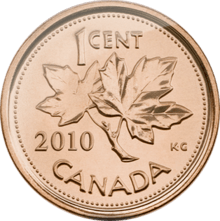 | |
| Design | Maple leaf branch |
| Designer | G.E. Kruger Gray |
| Design date | 1937 |
In Canada, a penny is a coin worth one cent, or 1⁄100 of a dollar. According to the Royal Canadian Mint, the official national term of the coin is the "one-cent piece", but in practice the terms penny and cent predominate. Originally, "penny" referred to a two-cent coin. When the two-cent coin was discontinued, penny took over as the new one-cent coin's name. Penny was likely readily adopted because the previous coinage in Canada (up to 1858) was the British monetary system, where Canada used British pounds, shillings, and pence as coinage alongside U.S. decimal coins and Spanish milled dollars.
In Canadian French, the penny is called a cent, which is spelled the same way as the French word for "hundred" but pronounced like the English word (homophone of "sent"). Slang terms include cenne, cenne noire, or sou noir (black penny), although common Quebec French usage is sou.
Production of the penny ceased in May 2012,[1] and the Royal Canadian Mint ceased the distribution of them as of February 4, 2013.[2] However, like all discontinued currency in the Canadian monetary system, the coin remains legal tender. Once distribution of the coin ceased, though, vendors were no longer expected to return pennies as change for cash purchases, and were encouraged to round purchases to the nearest five cents.[3] Non-cash transactions are still denominated to the cent.
Description
Like all Canadian coins, the obverse depicts the reigning Canadian monarch at the time of issue. The final obverse depicts Queen Elizabeth II; her likeness has seen three design updates, the first occurring in 1965, a 1990 update to the design of Dora de Pedery-Hunt, and the 2003 update designed by Susanna Blunt.[4] A special reverse side, depicting a rock dove, was issued in 1967 as part of a Centennial commemoration.[5] It was designed by the Canadian artist Alex Colville and its use in 1967 marked the only time the 1937 maple leaf design was not used for the penny before it was discontinued in 2012.[6] The maple twig depicted on the coin is botanically incorrect.[7] The phyllotaxis of the twig on the coin is clearly alternate while maples in fact always have opposite leaves.
The 2012 coin had a round, smooth edge, as was the case for most of the penny's history; however, from 1982 to 1996, the coin was twelve-sided. This was done to help the visually impaired identify the coin.[8] However, the new copper-plated zinc coin proved difficult to plate in the twelve-sided shape, so the Mint switched back to a round shape.[9]
History
The first Canadian cent was minted in 1858 and had a diameter of 1 inch (25.4 mm) and a weight of 1⁄100 pound (4.54 g). These cents were originally issued to bring some kind of order to the Canadian monetary system, which, until 1858, relied on British coinage, bank and commercial tokens (francophones calling them sous, an historical term from the French currency), U.S. currency and Spanish milled dollars. The coin's specifications were chosen with the intention of the coins also being useful as measuring tools. However, their light weight compared to the bank and merchant halfpenny tokens readily available at the time was a serious hindrance to their acceptance by the public. Some of the coins were even sold at a 20% discount, and were inherited by the Dominion government in 1867. Fresh production of new cents (with the weight increased to 1⁄5 ounce or 5.67 grams) was not required until 1876.[10]
The large cents of 1858–1920 were significantly larger than modern one-cent coins and even slightly larger than the modern 25¢ piece (its diameter being 23.88 millimetres or 0.940 inches). After Confederation, these large cent coins were struck on the planchet of the British halfpenny and were roughly the same value. Pennies were issued sporadically in the third quarter of the 19th century. They were used in the Province of Canada, New Brunswick, and Nova Scotia upon Confederation in 1867. New Brunswick and Nova Scotia had issued their own coinage prior to that date, with British Columbia, Prince Edward Island, and Newfoundland continuing to issue "pennies" until they joined Confederation. The coin was reduced in size to its current size to match the size of the American penny.[11]
1936 dot cent
The rare 1936 dot cent is as notable in Canadian numismatics as the 50¢ piece of 1921. There were four minted specimens of this coin, produced with the dot to show they were made in 1937 while the mint was waiting for new dies due to a delay caused by the abdication of King Edward VIII and the need to create new dies for his successor, George VI. The last one sold at Heritage Auctions in January 2010 for over US$400,000 (this does not include taxes). It was graded specimen 66 by the Professional Coin Grading Service. Three known examples are in private collections, making it one of the few coins lacking in the Ottawa Currency Museum.
1947 Maple Leaf issue
In contrast to the 1936 issues, the 1948 cents dated 1947 and specially marked are very common. These 1947 Maple Leaf coins were made while the dies were being changed to show George VI was no longer Emperor of India, as the title of "Emperor of India" was dropped from the titles of the Crown per article 7.2 of the Parliament of the United Kingdom's Indian Independence Act 1947.
Composition throughout history
| Years | Mass | Diameter/Shape | Composition[12] |
|---|---|---|---|
| 2000–2012 * | 2.35 g | 19.05 mm (3⁄4 inch), round | 94% steel, 1.5% nickel, 4.5% copper plating |
| 1997–1999 * | 2.25 g | 19.05 mm (3⁄4 inch), round | 98.4% zinc, 1.6% copper plating |
| 1982–1996 | 2.5 g | 19.05 mm (3⁄4 inch), 12-sided | 98% copper, 1.75% tin, 0.25% zinc |
| 1980–1981 | 2.8 g | 19.05 mm (3⁄4 inch), round | 98% copper, 1.75% tin, 0.25% zinc |
| 1978–1979 | 3.24 g | 19.05 mm (3⁄4 inch), round | 98% copper, 1.75% tin, 0.25% zinc |
| 1942–1977 | 3.24 g | 19.05 mm (3⁄4 inch), round | 98% copper, 0.5% tin, 1.5% zinc |
| 1920–1941 | 3.24 g | 19.05 mm (3⁄4 inch), round | 95.5% copper, 3% tin, 1.5% zinc |
| 1876–1920 | 5.67 g | 25.4 mm (1 inch), round | 95.5% copper, 3% tin, 1.5% zinc |
| 1858–1859 | 4.54 g | 25.4 mm (1 inch), round | 95% copper, 4% tin, 1% zinc (bronze) |
- Although the RCM states 2000 as the year of transition from zinc to steel, zinc-core cents were issued in every year of the 2000s, except 2008. Steel cents dated before 2002 are test pieces for calibrating coin-operated machines, and are very rare in circulation.
From May 2006 to October 2008, all circulation Canadian pennies from 1942 to 1996 had a melt value of over $0.02 CAD based on the increasing spot price of copper in the commodity markets. The break-even price for a 2.8 g solid copper penny is $1.61 USD/lb, with prices during this period reaching as high as $4 USD/lb.[13]
Abolition
There had been repeated debate about ceasing production of the penny because of the cost of producing it and a perceived lack of usefulness. In mid-2010 the Standing Senate Committee on National Finance began a study on the future of the one-cent coin.[14] On December 14, 2010, the Senate finance committee recommended[15] the penny be removed from circulation, arguing that a century of inflation had eroded the value and usefulness of the one-cent piece. A 2007 survey indicated that 37 percent of Canadians used pennies, but the government continued to produce about 816 million pennies per year, equal to 24 pennies per Canadian.[16] The Royal Canadian Mint had been forced to produce large numbers of pennies because they disappeared from circulation, as people hoarded these coins or simply avoided using them. In 2011 the Royal Canadian Mint had minted 1.1 billion pennies, more than doubling the 2010 production number of 486.2 million pennies.[17] In late 2010, finance committee members of the Canadian Senate estimated that the average Canadian had as many as 600 pennies hoarded away, taken out of circulation.[15]
On March 29, 2012, the federal government announced in its budget[18] that it would withdraw the penny from circulation in the fall of 2012. The budget announcement eliminating the penny cited the cost of producing it at 1.6 cents.[18] The final penny was minted at the RCM's Winnipeg, Manitoba plant on the morning of May 4, 2012.[19] Existing pennies will remain legal tender indefinitely;[20] however, pennies were withdrawn from circulation on February 4, 2013.[21] Only pennies produced in 1982 or later are still legally "Circulation Coins".[22] The Currency Act says that "A payment in coins [...] is a legal tender for no more than [...] twenty-five cents if the denomination is one cent."[23]
On February 4, 2013, Google celebrated the beginning of the end for the Canadian penny with a Google Doodle.[24] On the same day the Canadian Mint began melting down the estimated 35 billion pennies that are in circulation.[25]
Cash transactions are now rounded to the nearest 5¢.[26]
Commemorative editions
| Year | Theme | Artist | Mintage | Special notes |
|---|---|---|---|---|
| 1967 | Canadian Centennial | Alex Colville | 345,140,645 | Features a rock dove in flight. |
| 1992 | Canada 125 | G. E. Kruger Gray | 673,512,000 | Dated as '1867–1992'. |
| 2002 | Golden Jubilee of Queen Elizabeth II | G. E. Kruger Gray | 716,367,000 | Dated as '1952–2002'. |
First strikes
| Year | Theme | Mintage | Issue price |
|---|---|---|---|
| 2005 | First day cover | 1,799 | $14.95 |
| 2006 | With new mint mark | 5,000 | $29.95 |
Mintage
|
|
|
|
|
|
|
See also
- Dei Gratia Regina, which appears abbreviated on the face of the coin
References
- ↑ "Canada's last penny minted". CBC News.
- ↑ "Eliminating the Penny". Government of Canada. Retrieved 4 February 2013.
- ↑ "Phasing out the Penny". Department of Finance, Government of Canada. Retrieved 4 February 2013.
- ↑ http://www.mint.ca/store/mint/learn/faces-of-the-monarch-1100026?cat=Faces+of+the+Monarch&nId=1100026&nodeGroup=Learn
- ↑ The Charlton Standard Catalogue of Canadian Coins, W.K. Cross, p. 72, The Charlton Press, Toronto, Ontario, ISBN 0-88968-297-6
- ↑ http://www.mint.ca/store/mint/learn/history-timeline-4000020#.UYPys9deu8Y
- ↑ Mahoney, Jill. "$20 bill's maple leaf isn't Canadian, botanists say". The Globe and Mail. The Globe and Mail. Retrieved 13 September 2014.
- ↑ Coins of Canada, J.A. Haxby & R.C. Willey, Unitrade Press (2002), ISBN 1-894763-09-2
- ↑ Royal Canadian Mint Currency Timeline, p. 9.
- ↑ The Charlton Standard Catalogue of Canadian Coins, W. K. Cross, p. 57, The Charlton Press, Toronto, Ontario, ISBN 0-88968-297-6
- ↑ http://www.mint.ca/store/mint/learn/history-timeline-4000020#.UYPys9deu8Y
- ↑ "A national symbol–the 1-cent coin". Royal Canadian Mint. Retrieved 2012-01-15.
- ↑ Kitco – Spot Copper Historical Charts and Graphs – Copper charts – Industrial metals
- ↑ http://parl.gc.ca/common/Committee_SenProceed.asp?Language=E&Parl=40&Ses=3&comm_id=13
- 1 2 "Penny should be scrapped: Senate panel". CBC News. December 14, 2010. Retrieved March 31, 2012.
- ↑ "100th anniversary of the Canadian penny" (PDF). Desjardins Group. Retrieved March 30, 2012.
- ↑ "Canada's penny withdrawal: All you need to know". CBC News. April 2, 2012. Retrieved August 14, 2012.
- 1 2 "Budget 2012: Chapter 5: Responsible Management to Return to Balanced Budgets". Government of Canada. Retrieved March 30, 2012.
- ↑ "Canada's Last Penny: Final Cent Struck In Winnipeg Friday As Currency Killed". Canadian Press/Huffington Post Canada. 2012-05-04. Retrieved 2012-05-04.
- ↑ "The penny's days are numbered". CBC. 2012-03-29. Retrieved 2012-03-29.
- ↑ Pedwell, Terry (30 July 2012). "A penny saved: Canadian coin to stick around until 2013". The Vancouver Sun. The Canadian Press. Retrieved 31 July 2012.
- ↑ Royal Canadian Mint Act R.S.C., 1985, c. R-9: Section 6 - "Non-circulation Coins" and "Circulation Coins"; Part 1 - "Non-circulation Coins"; Part 2 - "Circulation Coins"
- ↑ "Canada Currency Act". Retrieved 2012-10-26.
- ↑ "Canadian penny honoured with Google Doodle". The Toronto Star. 4 February 2013. Retrieved 4 February 2013.
- ↑ "A penniless Canada: Mint begins years-long process of collecting and melting down 82-million kg in coins". The National Post. 4 February 2013. Retrieved 4 February 2013.
- ↑ "Phasing out the penny - Rounding". Royal Canadian Mint. Retrieved 24 May 2016.
- ↑ https://www.jandm.com/script/getitem.asp?CID=3&PID=76
- ↑ http://www.mint.ca/store/mint/learn/1-cent-5300004#.V2MnY_krL4Y
External links
| Wikimedia Commons has media related to Penny (Canadian coin). |
- Value of Canadian Pennies
- Coinage Designs of 1967
- All you need to know about Canada's penny withdrawal CBC News, March 30, 2012.
